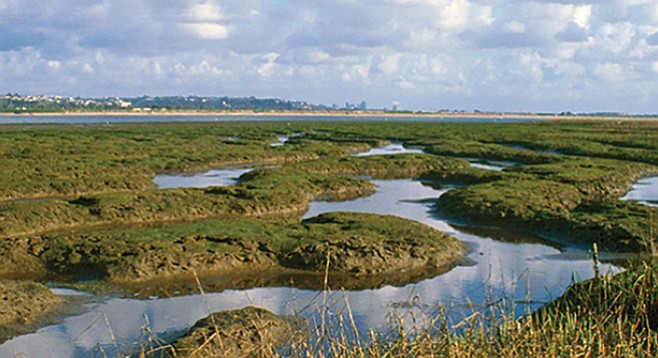 Facebook
Facebook
 X
X
 Instagram
Instagram
 TikTok
TikTok
 Youtube
Youtube

There were approximately 2000 acres of wetlands in and around Mission Bay fed by three sources — the San Diego River and Rose and Tecolote creeks. The San Diego River used to feed both bays, but the Army Corps of Engineers diverted the flow away from San Diego Bay in 1852. The San Diego River was channelized to bypass and protect the new Mission Bay Water Park in 1956, leaving only Rose and Tecolote Creeks as the tributaries.
In 1952, UCSD acquired 21 acres of the upper wetland from the Kendall and Frost families. The Kendall-Frost Mission Bay Marsh Reserve was created in 1965, a total of 40 acres along Crown Point Drive and Pacific Beach Drive to the west of Campland by the Bay. Though the public is not allowed access into the marsh, it is ideal for bird-watching.
The mudflats and channels are home to dense populations of annelid worms, crabs, and ghost shrimp that probing birds, such as willets, marbled godwits, dowitchers, curlews, and whimbrels, feed on. Osprey hunt larger fish while kestrels, marsh and red-tailed hawks, and peregrine falcons prey on smaller birds, mammals, and reptiles including gopher snakes and fence lizards.
The San Diego Audubon Society is looking for help expanding habitat for resident marsh species, creating a high-tide refuge for birds, and restoring the natural transition zone topography. They want volunteers to plant native plants, Saturday, January 9 from 9 a.m. to noon. Contact [email protected] or 858-273-7800 x106.


There were approximately 2000 acres of wetlands in and around Mission Bay fed by three sources — the San Diego River and Rose and Tecolote creeks. The San Diego River used to feed both bays, but the Army Corps of Engineers diverted the flow away from San Diego Bay in 1852. The San Diego River was channelized to bypass and protect the new Mission Bay Water Park in 1956, leaving only Rose and Tecolote Creeks as the tributaries.
In 1952, UCSD acquired 21 acres of the upper wetland from the Kendall and Frost families. The Kendall-Frost Mission Bay Marsh Reserve was created in 1965, a total of 40 acres along Crown Point Drive and Pacific Beach Drive to the west of Campland by the Bay. Though the public is not allowed access into the marsh, it is ideal for bird-watching.
The mudflats and channels are home to dense populations of annelid worms, crabs, and ghost shrimp that probing birds, such as willets, marbled godwits, dowitchers, curlews, and whimbrels, feed on. Osprey hunt larger fish while kestrels, marsh and red-tailed hawks, and peregrine falcons prey on smaller birds, mammals, and reptiles including gopher snakes and fence lizards.
The San Diego Audubon Society is looking for help expanding habitat for resident marsh species, creating a high-tide refuge for birds, and restoring the natural transition zone topography. They want volunteers to plant native plants, Saturday, January 9 from 9 a.m. to noon. Contact [email protected] or 858-273-7800 x106.
Comments